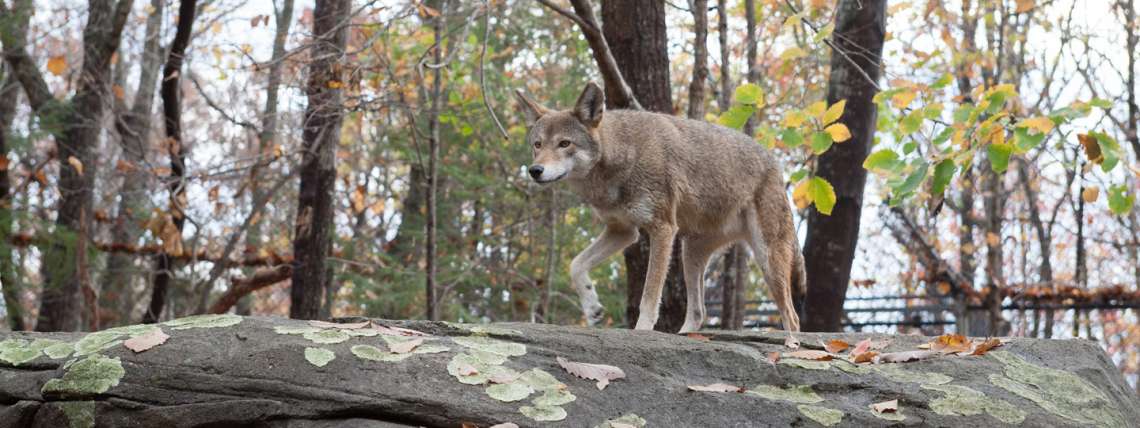Welcome!

Chris Lasher with a red wolf pup. (NC Zoo photo)
NC Zoo leads nation in efforts to save the red wolf
ASHEBORO — There are 243 red wolves being held in 47 institutions, including 35 at the North Carolina Zoo. Only 8-15 are running wild, all of them in northeastern North Carolina.
Those figures come from Chris Lasher, animal management supervisor at the NC Zoo. He has spent 12 years in the red wolf survival program and leads the nation in their protection.
Reid Wilson, secretary of the NC Department of Natural and Cultural Resources, told members of the Zoo Council during a video conference on Feb. 9 that the zoo, and Lasher, are leading the nation in the efforts to save the red wolf from extinction.

Wilson said he couldn’t emphasize enough “how important the zoo is in the efforts to save the red wolf. Chris Lasher is the national leader.”
Wilson said the US Secretary of the Interior recently visited the NC Zoo to see the animals and understand the challenges they face.
“The Secretary peppered the staff with questions about expanding releases (into the wild) and how to minimize deaths,” Wilson said.
“The zoo is the leader in figuring out how to integrate red wolves into the wild. I’m impressed with the knowledge of our experts.”
Later, zoo director Pat Simmons told the council that Garden & Gun Magazine was on site recently getting information and images about the American red wolf breeding program. The magazine did a story in July 2020 about the zoo’s red wolf population.
Lasher appeared by Youtube in November with the Dilworth Rotary in Charlotte to talk about the red wolf. He said the importance of saving the species revolves around it being an apex predator, meaning it controls all other species beneath it. With the decline of the red wolf in the Southeastern US, white-tail deer populations have skyrocketed. A healthy wolf population would help control the numbers of deer. Red Wolves also prey on raccoons, possums, field rats and squirrels.
Lasher told the Rotarians that the first red wolves arrived at the NC Zoo in 1995. Two years later, the first puppies were born. By 2021, there were 35 wolves at the zoo, including three litters totaling 12 puppies born that year.
There are now 10 wolf propagation pens at the zoo with plans to increase the capacity to 20 pens, from one-half to three acres.
Lasher said the reasons for the NC Zoo being a leader in the red wolf protection plan include the expertise of its staff, a large amount of land available, the nearness to the wild red wolf recovery area and being in the historic range of the species.
More NC Zoo news
ASIA UPDATE — During her presentation to the Zoo Council, Simmons said plans for the new continent of Asia are well under way, with construction documents approved and bids going out in a few months. She said ground-breaking should take place “within the year.”
Simmons said construction of Asia is expected to take 2-3 years but that there would be hard-hat tours and soft openings during the interim.
ELECTRIC VEHICLES — The zoo received a federal grant of $4.5 million for electric vehicles and to update the radio system, according to Simmons. Jason Joines has been hired as the new safety officer.
STRATEGIC PLAN — Simmons said the zoo’s staff has been working on a new strategic plan with the mission “to protect wildlife and wild places.” Its four goals include:
— Wildlife and wild places.
— The well-being of employees.
— Community engagement.
— Economic responsibility.
ZOO EDUCATION — Beth Folta, curator of education, talked about using a $20,000 gift from T-Mobile to provide 590 kits for elementary schools in five counties. The kits provide materials that support playful learning practices and outdoor experiences.
Folta also explained a new zoo education app to help underserved audiences, such as those speaking Spanish, with low vision or blindness, and also for school groups. Also developed was the Zoo Trekker, an activity book that visitors complete while touring the zoo. These educational materials were made possible by a $1 million grant by GlaxoSmithKline.
